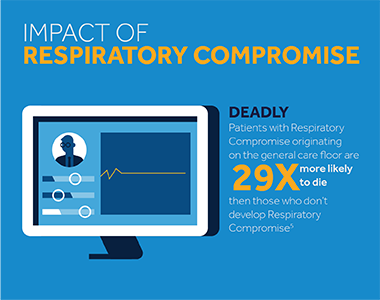The Impact of Respiratory Compromise
 Respiratory Compromise is the leading cause of ICU admissions1, rescue calls2, and ‘code blues’.3
Respiratory Compromise is the leading cause of ICU admissions1, rescue calls2, and ‘code blues’.3
It is expected to cost the U.S. system $37 billion by 20194, has a mortality rate 29 times that of patients without RC5, and yet it was judged preventable 64% of the time.6
Click here to view more information on the impact of RC. Or, view additional resources on RC.
TOPIC: Respiratory Compromise
1 Society for Critical Care Medicine – Critical Care Statistics. http://www.sccm.org/Communications/Critical-Care-Statistics
2 Curry JP and Jungquist CR. A critical assessment of monitoring practices, patient deterioration, and alarm fatigue on inpatient wards: a review. Patient Safety in Surgery 2014, 8:29. http://www.pssjournal.com/content/8/1/29
3 Schein RM, Hazday N, Pena M, Ruben BH, Sprung CL. Clinical Antecedents to In-hospital Cardiopulmonary Arrest. Chest (1990) 98; 6,1388-92.
4 Agarwal SJ, Erslon MG, Bloom JD. Projected Incidence and Cost of Respiratory Failure, Insufficiency and Arrest in Medicare Population, 2019. Annual Meeting of Academy Health, June 2011; Poster 567.
5 Kelley SD, Agarwal S, Parikh N, Erslon M, Morris P. Respiratory insufficiency, arrest and failure among medical patients on the general care floor. Crit Care Med 2012; 40(12):764.
6 Hodgetts TJ, Kenward G, Vlackonikolis I, Payne S, et al. Incidence, location and reasons for avoidable in-hospital cardiac arrest in a district general hospital. Resus 2002; 54:115-123